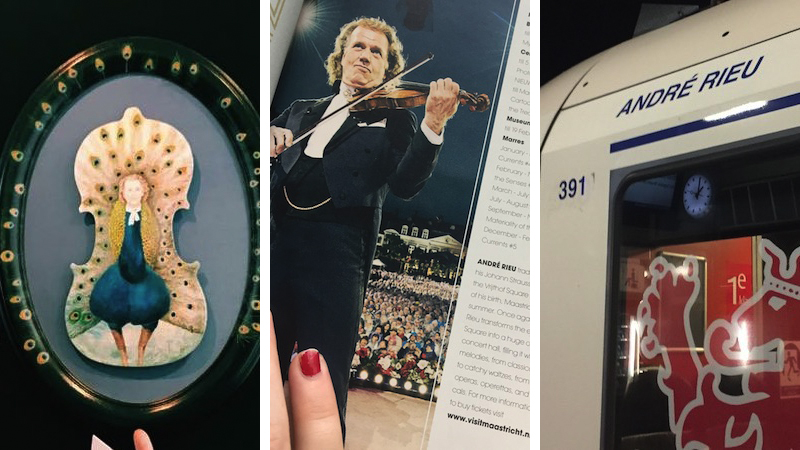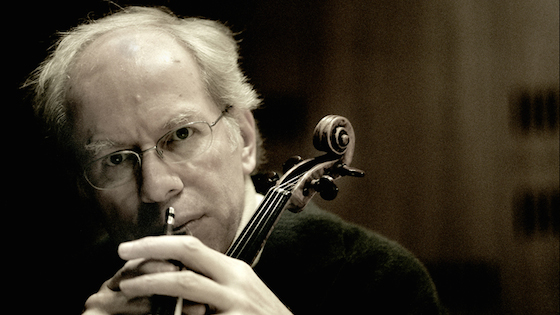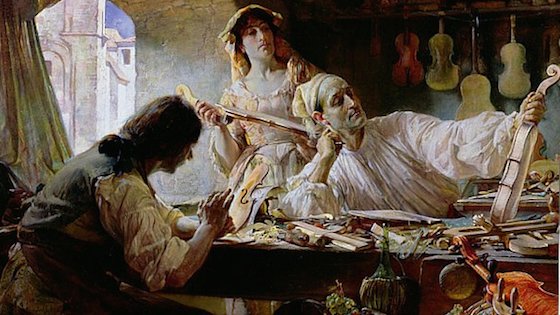By Laurie Niles: The reason why violinist
Endre Granat decided to create
his own edition of the 24 Caprices by Niccolo Paganini was very simple: "Every time I had a student come and play a Paganini Caprice, I had to spend half of the time correcting the music," Granat said, speaking with me at his home in Studio City, Calif. earlier this year. "Not the playing, but the music!"
![]()
Why? Most editions of the 24 Caprices contain a host of errors, including wrong notes, changed bowings, misplaced accidentals, misleading tempo markings, and more. The widely-used International Edition, in particular, has been
called out on a number of occasions for its inaccuracies.
"I found that students had gotten used to interpretations that are not inherent in the original manuscript," Granat said. For example, take the beginning of Caprice No. 13, one of the more well-known and commonly-played Caprices. For many years, a majority of people used an edition that started this Caprice with two eighth notes slurred, while the manuscript shows two staccato eighth notes under a slur. "These are totally different things!" Granat said. "It misleads you. Which is why the 13th Caprice -- which is all up-bow, off-string, staccato in the first part of the Caprice -- is usually played like a dirge." Because so many editions in the past showed these smooth slurs, "it's totally misinterpreted. You would never do that if you have seen the original."
Now that
Paganini's original manuscript is posted on IMSLP for all the world to scrutinize over the Internet, it makes no sense to continue to perpetuate these fundamental errors.
Granat, who studied the Caprices with Jascha Heifetz, sought to create an edition that was as true as possible to the manuscript, while also incorporating the fingerings, bowings and performance suggestions he learned from Heifetz. Granat, who has had a distinguished career in performing, film recording and teaching, also counts Zoltan Kodaly, Gyorgy Ligeti and Josef Gingold among his teachers.
Granat's first plan was to turn to the various urtext editions that have been published. "I thought, I can use the urtext and just put in some decent fingerings - and we are in business," Granat said. "I had the surprise of my life when I found out that the urtext editions are wrong!"
"So I went back to the actual manuscript of Paganini," Granat said. "When I started working with the manuscript, it was one discovery after another."
![Endre Granat]() Endre Granat. Photo by Violinist.com.
Endre Granat. Photo by Violinist.com.
"Paganini's handwriting is good, it's readable, and he made surprisingly few mistakes," Granat said. "Many of those mistakes are very easily correctable." For example, it's possible to compare sequences, and any shortcuts in Paganini's notations tended to be pretty consistent.
Paganini did not publish any of his own compositions until rather late in his life. "Paganini was a great violinist who was very busy playing concerts, then suddenly out of nowhere, in 1817, he showed up at the doorsteps of Ricordi, a famous Italian publisher," Granat said. "That is when he sold his caprices and a couple of other pieces. He was 35 years old. If you think about it, Mozart died when he was 36, and Paganini didn't published a thing until he was 35!"
"The Caprices are Op. 1," Granat said. "That doesn't mean this was his first piece ever; it means this was the first piece ever in that kind of setting, in other words, solo violin. He may have had other pieces in his mind for string quartet, for flute, for guitar whatever. But in the print, this is Op. 1, first published work ever. It came out in 1820, three years later."
"The interesting part, and the frustrating part, is that by that time, Paganini was off somewhere else playing concerts, and he never once bothered to proofread it," Granat said. "Then after that, the second printing, by the same publisher, came in the 1830s - guess who didn't proofread it again? In his lifetime, there were several editions in Italy, some in France, some in Germany, and a common thread is that Paganini never proofread any of those."
Having edited some 20 sheet music editions in his
Sevcik series and the
Heifetz series, Granat knows well the importance of the proofreading step in the process. Once it goes to print, the errors are no longer correctable, "so it's tremendously important."
Adding to the mystery around these works is the fact that the records show no evidence of Paganini ever performing his own caprices. "Paganini never programmed any of his caprices, in his entire lifetime, not before they were published, and not after they were was published," Granat said. "He may have he performed some of them at private parties, or possibly as an encore. But he never programmed a single one of them."
Paganini actually had more formal training as a composer than as a violinist, Granat said, because as a violinist, he was largely self-taught.
Granat feels that, in many respects, Paganini wrote the Caprices in the mind-frame of a composer. "I don't know who he wrote this for -- but not for himself, he never played it." Writing as a composer, many of the slurs shown in the manuscript indicate phrasing, rather than performance bowings, Granat said. When it comes to fingerings, "somebody put some fingerings in the manuscript," Granat said, but musical historians have ascertained, through graphological tests, that they were not written by Paganini himself.
At the same time, Paganini's abilities as a violinist certainly play into what he created in the 24 Caprices, and certain slurs are meant to indicate specific bowings. It takes a knowledgeable violinist to know the difference.
Granat, certainly a knowledgeable violinist, literally looked at the manuscript under a magnifying glass.
"Certain urtext editions have been edited by musicologists who couldn't quite understand what was happening," Granat said. "For example, they couldn't understand that Paganini was capable of playing a chord in the middle of a slur. They said that's impossible. Because three measures before, the chord came on the downbeat. So they changed it." This example occurs in Caprice No. 4, measures 12-15.
![Paganini Caprice 4 errors]() Paganini Caprice No. 4, Measure 12: left, an "urtext" edition; right, the manuscript.
Paganini Caprice No. 4, Measure 12: left, an "urtext" edition; right, the manuscript.
"So suddenly you have an urtext which is not an urtext," Granat said. "It's the lack of attention and the lack of asking somebody capable."
It's also helpful to understand how all these editions evolved, historically.
First came the two editions by Ricordi - the never-proofread originals. Granat sums those up as "a disaster. The original is bad. The second Ricordi, someone fixed some things, but then made other mistakes." After that came an edition by Breitkopf, which "is very important because that was done by Ferdinand David, who was an excellent musician and violinist," Granat said. "The basis for his edition was the (original) Ricordi. David was an excellent musician, and he looked at that and said, 'It cannot be.' So David fixed some things, but he was not Paganini, he didn't know what Paganini wrote. He wrote something that he thought was good; unfortunately, it has nothing to do with Paganini." Then came about 50 more editions, "all based either on Ferdinand David or they are based on the original edition. In either case, not acceptable, truly not acceptable."
The International Edition has been widely available, but again, it strays quite far from the manuscript. "Looking at the Flesch edition -- Flesch was an okay violinist and he certainly was a great pedagogue," Granat said. "His fingerings are quite okay for the time but that was probably printed in 1930 - it's kind of long in the tooth."
"Galamian -- the less we talk about, the better," Granat said.
It's important to keep a few things in mind about Paganini and his playing. Though he certainly had some special abilities, they were not supernatural or beyond the (literal) reach of a well-trained violinist. Here are some of the unique features of Paganini's playing and approach:
He could reach very wide intervals
Paganini's ability reach tremendous stretches is legend, but he did employ a few tricks, Granat said. "Paganini, as a matter of habit, tuned the violin up a half-step, every single string. G string occasionally up a minor third, in other words the G would be B flat," Granat said. "Not always, but generally speaking, up a half-step. One of the famous things he could do was to play the four A flats: A flat first finger G string, A flat second finger D string, third finger A string fourth finger E string. Just thinking about it gives me a hernia. But that's not what he played! He played open A flat, and then the other three, which is very easily reachable by the average hand. So, so much for that." So then, how does one reach a 13th, as written in the first and third caprices? Even a 10th is difficult. "I tried it, faked it, did anything I could," Granat said, "until I was at a guitar recital. I looked at the way guitarists play: they reach back and they play with the side of the nail joint on the guitar for the big stretches. I tried it on the violin, and it worked like a charm."
He used the entire fingerboard
"Paganini went from one end of the fingerboard to the other, and not just on one string but on all of them," Granat said. "He was instigating the change of the Baroque instrument into a modern instrument: raising the neck, lengthening the fingerboard, changing the bass bar. Those are all Paganini's innovations. By 1850, 10 years after his death, most every violin had been converted, and that is what we use today."
"Paganini played on a Guarneri del Gesù, he was the first major violinist who played on a Guarneri del Gesù. Violinists up until that time, up until 20 years before, played on Amatis, Steiners, small Italian instruments. Viotti brought in Stradivari; Paganini brought in Guarneri del Gesù," Granat said. "Paganini has a very small sound because, in order to be able to play on the uppermost positions of the violin, he put the fingerboard up, pulled the bridge down, so there was hardly any room between the fingerboard and the string, so he couldn't press. He played with a very speedy bow and very little pressure."
He used harmonics in a way that was innovative for his day
"Up until his day, there was no standard notation for harmonics, and if you look at old edition, you will see that the actual sound is notated, leaving the poor violinist to his own devices, in terms of how to play them and where to play them," Granat said. "Paganini didn't just play single-note harmonics; but double-stops and triple stops."
He was a master of left-hand pizzicato
"He was able to play a melody with his bow, and accompany himself with pizzicato. There are quite a few such compositions of his," Granat said. "The Caprices, on the other hand, don't contain a single note in harmonics, and only one variation, in the 24th Caprice, with a very simple pizzicato." Why is that? "I think the reason was, since this was his Opus 1, he wanted to appear to be a very serious composer who doesn't rely on things like this, which in those days were considered tricks," Granat said. "Today we know they are not 'tricks,' you get a new aspect of violin-playing. But he wanted to appear to be very serious. I don't know whether that's really the case, but that's the only explanation I can find."
He used a "transitional" bow
"The violin bow as we know it today, the Tourte bow, was developed prior to the French Revolution (the 1790s). Viotti was working together with Tourte to develop the bow. Before the bow as we know it, Tourte made many kinds of bows: shorter ones, longer ones, using different types of wood," Granat said. "Paganini started with a transitional bow: not a Baroque bow at all, but not a modern bow either." Paganini's favorite bow was made by the French bow maker
Jacob Eury, a contemporary of Tourte.
Paganini used thin strings
"He used plain gut E, A, D - that was all that was available - and a wound-gut G. He used amazingly thin strings," Granat said. "I've seen them; they are unbelievably thin. That is yet another reason why Paganini had a small sound. But he used them because the harmonics spoke much better and playing the high notes was much easier on his hand. He didn't have to press down because the string didn't have much resistance."
Leopold Auer, the great Russian pedagogue who taught Heifetz, was among the first to espouse the Caprices and use them in his teaching. In turn, Heifetz did the same. Granat remembers what Heifetz used to say to his students: "Bach is the Old Testament, and Paganini is the New Testament."
"He gave equal time to both," Granat said. "Paganini was very much core material in Heifetz' class. It was frightening, how he could play any one of them, at any time, without any notice. Every one of them, any part of it! Not like the typical violin teacher who picks up the violin and
demonstrates the early, easy part and says, 'etc. etc.' when the notes get dark on the page. He could play those parts also!"
He expected the same of his students. If a student protested that something was too difficult, Heifetz simply said, "Go home and practice until it's not difficult!" If a student said, "I can't play it," Heifetz said, "Fine, come back when you can."
"You could not say 'I cannot play these,'" Granat said. "If you cannot play these, then don't do it. Do something else, there are many other wonderful professions."
Granat's new ediiton is available through Hal Leonard, click here.You might also like:
![Ida and father-in-law]()




 You are welcome to skip down to those videos, but for those who are curious about the small city in northern Italy that has meant so much to violinists and string players, here is the little history: Cremona was the birthplace of some of the world's finest violins, carrying names such as Amati, Bergonzi, Guarneri, Ruggeri and Stradivari. But after its glory days of violin-making in the 16th, 17th and early 18th centuries, Cremona's violin-making industry fell into relative obscurity for a long period, going well into the 20th century.
What's notable is the way Cremona is working on a comeback this century -- in a big way. In 2013, the 10 million
You are welcome to skip down to those videos, but for those who are curious about the small city in northern Italy that has meant so much to violinists and string players, here is the little history: Cremona was the birthplace of some of the world's finest violins, carrying names such as Amati, Bergonzi, Guarneri, Ruggeri and Stradivari. But after its glory days of violin-making in the 16th, 17th and early 18th centuries, Cremona's violin-making industry fell into relative obscurity for a long period, going well into the 20th century.
What's notable is the way Cremona is working on a comeback this century -- in a big way. In 2013, the 10 million 















